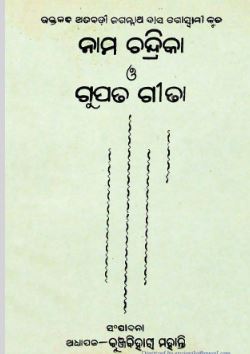The spiritual realm has always been a rich field of exploration, offering insights into the human condition, existence, and the divine. Among the vast array of spiritual texts, Nama Chandrika O Gupata Gita, edited by the venerable Jagannath Das and the distinguished Kunjabihari Mohanty, stands as a significant contribution, illuminating the serene path of Nirgun, engaging in profound spiritual dialogues with Uddhab, and delving into the essence of Chaturddha Murti. Published in 1979, this text continues to resonate deeply with spiritual seekers and scholars alike.
Nirgun, a central theme in many spiritual traditions, is the concept of the formless, attribute-less Supreme Reality. It’s a notion that transcends the limitations of human perception and description. In this text, Nirgun signifies the divine essence that exists beyond the grasp of human language and thought, a reality that can only be truly understood through direct spiritual experience.
Jagannath Das and Kunjabihari Mohanty intricately weave the concept of Nirgun into their discussions, offering readers a pathway to realizing the ultimate formless divine. The duo’s commentary is a vessel through which ancient wisdom is transmitted to contemporary audiences, ensuring the timeless relevance of these teachings.
Uddhab, a devotee of Lord Krishna and a significant figure in Hindu mythology, stands as a symbol of unwavering devotion and wisdom. The dialogues with Uddhab in Nama Chandrika O Gupata Gita highlight critical philosophical and theological issues, providing readers with profound insights into the nature of devotion (bhakti) and knowledge (jnana).
These dialogues are rich with metaphors and parables, creating a dense tapestry of spiritual wisdom. Uddhab’s conversations are not just philosophical discourses but serve as practical guides for leading a life of virtue and devotion. They address age-old questions about the human soul, its journey, and its ultimate reunion with the divine.
The concept of Chaturddha Murti refers to the fourfold manifestation of the divine, representing different aspects of the same ultimate reality. This multifaceted approach allows for a comprehensive understanding of God, encompassing various attributes and forms. In discussing the Chaturddha Murti, Jagannath Das and Kunjabihari Mohanty provide a framework for appreciating the diverse manifestations of the divine, each playing a unique role in the cosmos.
This fourfold concept underscores the idea that while the divine may appear in multiple forms, its essence remains unified and singular. This synthesis of diversity and unity is a recurring theme in many spiritual traditions and is adeptly handled in Nama Chandrika O Gupata Gita.
Published in 1979, Nama Chandrika O Gupata Gita continues to serve as a beacon of spiritual light for seekers worldwide. The efforts of Jagannath Das and Kunjabihari Mohanty in bringing forth this text have ensured that the spiritual wisdom encapsulated within is accessible to future generations. Their painstaking scholarship and deep understanding of these profound spiritual themes have created a text that not only educates but also inspires.
In conclusion, Nama Chandrika O Gupata Gita stands as a testament to the eternal quest for spiritual truth. Through its exploration of Nirgun, the enlightening dialogues with Uddhab, and the comprehensive portrayal of Chaturddha Murti, the text offers a profound spiritual journey. As we tread this path, guided by the wisdom of Jagannath Das and Kunjabihari Mohanty, we are invited to transcend our limited perceptions and experience the divine essence in its ultimate, formless reality.
Books Info
| Books name | Nama Chandrika O Gupata Gita/ନାମ ଚନ୍ଦ୍ରିକା ଓ ଗୂପତ ଗୀତା |
| Editor | Jagannath Das; KKunjabihari Mohanty |
| No Of pages | 49 |
| Publisher | Sri Gopinatha Das Goswami |
| Publication | 1979 |
| Printed At | Sroi Bharati Press |
| Distributor | Na |

